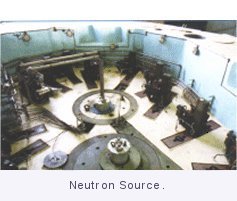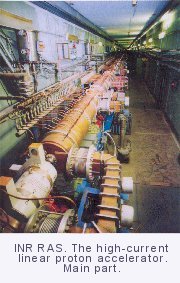RADIATION... FOR LIFE*)
Ten years have already passed since first steps on producing intensive proton beams were taken at a high-current linear accelerator of the Institute for Nuclear Research of the Russian Academy of Sciences (INR RAS).
According to the project the Linac may provide an average hydrogen ions current of 500 mA at the energy of 600 MeV.
For now the accelerator of this type still remains a unique research tool both in Europe and Asia.
The research center was built on the basis of a high-current accelerator of INR RAS in Troitsk in a such way as to provide mutual experiments of Russian and foreign scientists in the field of fundamental and applied problems of the up-to-date nuclear physics as well as interdisciplinary sciences.
One of the main reasons for choosing for this purpose high-current accelerators, which are often simply called meson factories, was a high intensity of the secondary particles produced when hydrogen ions interact with the target nuclei. The similar multipurpose research centers operate in Los-Alamos National Laboratory (LANL) in the USA, in Paul Scherrer Institute (PSI) in Switzerland and in Canada (TRIUMF).

Neutron complexes appeared to be very promising in using spallation neutrons for studies of rare and fine mechanisms of neutron-nuclear interactions, for examination by neutron methods of structure and dynamics of condensed matter, for non-destructive control of internal changes in different materials under mechanical and radiation loads and during phase transformations. The studied phenomena are tightly connected with various problems of nuclear power engineering.
Nowadays a new generation of neutron sources on the basis of high-current accelerators is coming to life. A USA project SNS (Oak Ridge) is under way now, a presentation of European project ESS took place in 2002, a Japanese source is being developed. When designing a new generation of complexes "a high-current accelerator - neutron target stations" a great experience of INR RAS in this sphere is sure to be taken into consideration.
Neutron sources on the basis of accelerators with the usage of multiplying targets are so called accelerator-driven systems (ADS). They are supposed to help in solving a very difficult problem - to burn long-lived radioactive waste of a nuclear fuel cycle.
Many densely populated European countries are facing the problem how to convert long-lived radioactive components of the used nuclear fuel (UNF) into rapidly decaying isotopes. Some countries put forward special research programs for solving this problem. The project TRIGA developed by a Nobel prize winner professor Karl Rubbia seems to be the most promising.
It should be stressed that foreign specialists are very interested in Russian experience in ADS technology elaboration. Professor Karl Rubbia proposed to join efforts to create a demonstration device for burning minor actinides and transmutation of long-lived radioactive UNF components.

The Ministry for Atomic Energy of the Russian Federation, Russian Academy of Sciences and Russian Scientific Center "Kurchatov Institute" decided to create a working group for cooperation of scientists of Russia and European Community to solve the ADS problems. The existing neutron complex of INR RAS is supposed to become a basis for installation for international demonstrational experiments on nuclear transmutation of minor and long-lived fission products. The data obtained will be used for creation of a more powerful installation of a semi-industrial type according to the project of the State Scientific Center "Institute of Physics and Power Engineering" (IPPE) in Obninsk.
The Institute for Nuclear Research possesses a high-current accelerator in action, necessary basis for irradiation experiments and experienced staff. This May a joint team of researchers of INR RAS and IPPE carried out experiments at the Lead Slowing-down Neutron Spectrometer and obtained new data on interaction of neutrons and minor actinides. INR RAS has also good contacts with such MinAtom centers as the Russian Scientific Center "Kurchatov Institute", Institute for Theoretical and Experimental Physics, Joint Institute for Nuclear Research (Dubna) and others. To join efforts, including international cooperation, is a necessary condition for solving a very difficult but ecologically, economically and strategically important problem of development of ADS technology for UNF burning.
Vice Director on science E.A. Koptelov
*) Translation of the article in the "Sodruzhestvo" newspaper (June 2003, N 12-13, a special issue for the 50th Anniversary of the Ministry for Atomic Energy of the Russian Federation)
WWW.INR.RU 2001 © webmasters